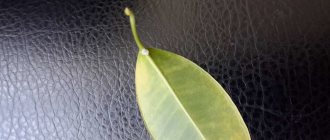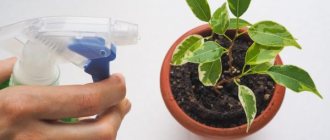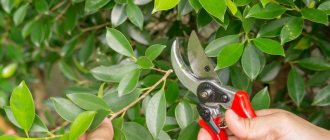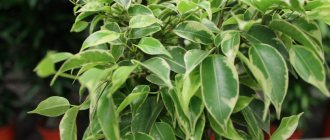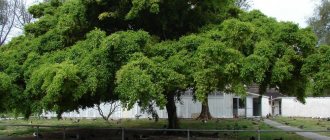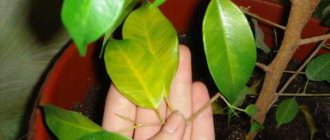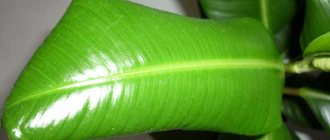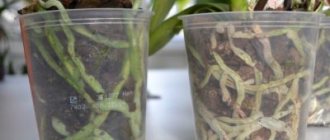Plants » Flowers
0
2915
Article rating
Kira Stoletova
Ficus is very popular, especially a variety like Benjamin. It is unpretentious and easy to grow at home. All this plant needs is good watering and timely feeding. Despite the unpretentiousness of the flower, diseases of Ficus Benjamin can still cause inconvenience to its owners. And besides ailments, it can also be attacked by various parasites.
Ficus benjamina diseases
Most often, diseases and pests in plants occur due to improper care or infection from other flowers. Ficus, like humans, needs to be prevented from various types of ailments. Diseases and pests of Ficus Benjamin with photos can be easily found on the Internet. So why do diseases occur in this plant?
Causes of ficus diseases
A plant of this species may become covered with pale spots or the leaves may turn yellow. Most often, this does not mean that Benjamin’s ficus has contracted some kind of disease. To make sure of this, you first need to assess its location. Maybe he just doesn't get enough sunshine. We need to try moving it to a more illuminated place.
Diseases can also occur due to insufficient watering. During this period, the leaves become dry and begin to fall off.
This flower needs to be watered quite often, otherwise it will simply die, but this does not mean at all that the plant needs to be watered. No flower can handle a lot of water.
Ficus benjamina was bred in warm countries, so the temperature in the house should be somewhere around 23°C. If the air is cold or the flower gets used to standing in a draft, it will simply shed its leaves, and very high temperatures can cause the plant to turn dark brown.
If the plant does not receive enough nutrition, it will be attacked not only by diseases, but also by pests, so not only regular watering should be carried out, but also the application of mineral fertilizers. It is necessary to feed the flower at least once a month.
Ficus diseases: description and effective treatment methods
Diseases of Ficus Benjamin can significantly damage the plant, and in some cases even destroy it.
What should you do if your ficus leaves turn red or have white spots, mites, aphids and white or red dots? You need to act immediately.
If you do not purchase special medicinal products in time and do not rid the sick houseplant of pests and diseases, as well as white lumps, it may simply die.
In addition, what makes an invasion of parasites dangerous is the increased risk of a similar problem occurring in your other evergreens. Study the most common diseases of ficus, determine the source of the outbreak of the flower disease, and then proceed to full treatment.
Leaf diseases
Why do ficus leaves fall off? There may be several reasons why the plant is sick. Among the most common diseases of the leaf blade of home ficus, the following are worth highlighting:
- yellowing of foliage. As a rule, this problem occurs in winter. Heating devices are actively working in the apartment, and hot air flows are often directed at indoor plants. For a sick ficus, this factor will be disastrous. The leaves begin to turn yellow, wither and gradually fall off. When a flower sheds its leaves en masse, it stops growing and may die. The best solution for you is to move the flowerpot with the evergreen specimen to another, much more suitable place. However, be careful when looking for a new corner to place your ficus pot. If you disturb it too often, the yellowing of the foliage may begin again, but this time the ficus will get sick due to the stressful situation you created;
- shredding or falling leaves. Such ficus diseases also pose a serious danger to the plant, so they must be treated as quickly as possible. The diseased plant gradually withers, and the reason for this is a lack of nutrients in the soil. The situation can be corrected. To do this, it is necessary to replant the plant, completely replacing the soil composition;
- yellowness of the tips of the leaves, the appearance of yellow spots. This problem indicates an excess of moisture in the soil. Do not forget that ficus loves moisture, but watering should be moderate. Be sure to let the soil dry before irrigating the substrate again. For an indoor flower, a lack of moisture will be much less destructive than its excess;
- dropping leaves at the bottom of the trunk. This reason is considered natural - each ficus leaf blade develops within three years, and then ages and falls off. However, the trunk cannot be completely exposed, since in this case it will be very difficult to save it. If you observe the fulfillment of unsuccessful predictions, it’s time to replant the flower or add complex mineral fertilizers to the soil;
- pests on ficus leaves. As a result, the leaf blade dies sooner or later if treatment is not taken. You can get rid of pests with the help of special insecticidal preparations, which you need to buy in the store.
If Ficus Benjamin gets sick, the main thing is to determine the cause of the disease as soon as possible. Only after this begin to treat your ficus.
Infectious diseases
If various pests appear on the leaves of Ficus Benjamin, you can fight them quite effectively, especially if you noticed the problem at an early stage. But if you are faced with infectious diseases, it is much more difficult to cure the plant from them.
The first signs are difficult to notice, and when a flower is seriously ill, even the most effective methods do not always give the desired result. To defeat infectious diseases of ficus plants, it is necessary to take a closer look at what plant ailments a domestic gardener may encounter, and what to do in this case.
Fungal diseases
Fungal diseases of ficus are considered the most dangerous for the plant. If pests of Ficus Benjamin are removed using high-quality insecticides, in some cases a green specimen affected by a fungal disease cannot be saved even by an experienced gardener. What specific ficus diseases fall into this category is worth studying carefully.
Gray rot
Among the diseases of the house ficus, which are the result of the activity of fungal formations on the flower, it is worth highlighting first of all gray rot.
The key sign of the disease is blackened leaves, which eventually fall off. As a rule, the disease appears due to excessively high humidity in the room.
In the fight against this disease, it is necessary to reduce the frequency of watering and also ventilate the room more often.
Sooty mushroom
Treatment of black plaque (and this is a key sign of the disease) may be necessary after the plant has been attacked by harmful insects. The initial stage of fighting the disease involves washing the flower with soapy water.
Soak a sponge in the liquid and carefully go over each leaf. The stem must also be treated with a fungicide. As a preventative measure, do not overwater the flower in the future. Irrigating the substrate with a solution of manganese will not hurt either.
It is advisable to carry out this procedure at least once a month.
Fungi on leaves
Among the fungal formations that mostly appear on leaf blades, it is worth highlighting cercospora, anthracnose, and botrytis. As such diseases develop, black, yellow or brownish spots develop on the leaves. If you don’t fight them, the same result awaits you: the death of the leaf blade.
The disease must be eliminated by removing the affected parts and treating the plant with a fungicide.
Root rot
If a ficus gets sick with root rot, it means that you did not follow the plant’s watering regime at one time.
In this case, the root system begins to actively rot, and the stems and leaves wither, gradually losing their brightness and acquiring a grayish color.
Interestingly, if the infection gets into the soil, it may not spread to the flower for some time. But sooner or later this will happen, and then the only correct solution will be to throw the plant and the pot in the trash.
Pests attacking the plant
Spider mites on ficus, thrips on ficus, mealybugs - all these parasites can cause a lot of harm to your green specimen. For example, an invasion of spider mites is not immediately noticeable. It is quite difficult to detect parasites on a flower when there are only a few of them.
But a huge colony of ticks is more difficult to fight. That's why it doesn't hurt to regularly inspect the flower to look for mealybugs or aphids on the stems and leaves. If aphids appear on a ficus, how to deal with them? Buy effective insecticides and carefully treat the flower.
Disease Prevention
Ficus benjamina aphids, thrips, mites or mealybugs can destroy your evergreen plant. So that it does not get sick in the future and does not die from another illness or pest invasion, you should remember the key points that are required for quality prevention.
Diseases and pests (plaque on the leaves, white lumps, mealybugs, spider mites, all kinds of redness and white coatings) appear primarily due to mistakes you made in caring for the flower. Do not over-irrigate the substrate, since waterlogging of the soil contributes to the development of fungal diseases.
Very often, gardeners try to save money by purchasing a cheap soil mixture or preparing it themselves. However, this is not the best solution, because you can introduce an infection into the soil, for which the ficus will then need to be treated.
“We save indoor plants from diseases”
From this video you will learn how to save indoor plants from various diseases.
Source: //grow-me.ru/komnatnye/fikus/bolezni-4-4422/
Optimal conditions for growth and avoidance of diseases of Ficus Benjamin
Often diseases appear in ficus due to the wrong location or air temperature, therefore, in order for the flower to be comfortable, it must be placed in a place where there is good lighting and no draft. Often it is a draft that causes the death of a plant. For Ficus Benjamin, the optimal air temperature is 15°C.
You need to water the flower in moderation. In the summer, this should be done no more than 2 times a week. In cold weather, watering is carried out once every 10 days. Only under such conditions of detention can the occurrence of various ailments be avoided.
Why do ficus trees get sick?
In general, tree-like species, such as Benjamina, Microcarpa, Binnendijka, are resistant and healthy plants, but they are also susceptible to infections.
Large-leaved ficus trees with a significant rubber content and late-hardening trunks - Elastica, Bengal, Lirata - suffer from diseases a little more often. Soft, loose tissues are more susceptible to rotting than wood and are less treatable.
Pathogens can be brought into the home with a new plant. Therefore, it is recommended to quarantine them for a month away from other flowers, and carefully monitor them for signs of infection.
Ficus diseases, especially various rots, are often accompanied by improper care, namely: overwatering, high humidity and extreme heat. You need to spray leaves at a temperature of 27-30° C in the morning or evening, but not in the middle of the day.
Fungal spores can be introduced:
- air flows during ventilation;
- pets;
- people touching flowers with dirty hands after walking or caring for infected plants;
- if the ficus stands on a balcony or street - by birds, insects, raindrops, wind;
The cause of the disease can also be contaminated soil or one of its components, or an old pot that has not been disinfected when reused.
Ficus benjamina pests
Proper care allows you to avoid a variety of diseases, but it is almost impossible to prevent the appearance of pests. The reason for their appearance can be varied. Most often they occur due to high humidity and unsuitable air temperature. If pests appear, but the leaves become sticky, spots and even cobwebs may form. One such parasite is the mealyworm, which is indicated by curling and wilting of leaves.
Ficus Benjamin is often affected by a parasite such as a mite. Because of this, the level of photosynthesis decreases, and over time the flower may even die. Another pest is aphids. Because of it, the leaves turn yellow and fall off over time. These ficus benjamina parasites with photos can be easily found on the Internet.
A brown spot indicates that the flower is being attacked by a scale insect. This parasite sucks all the juices out of the plant and leaves a sticky coating, which can cause sooty fungus to appear. In order to cope with scale insects, it is necessary to treat the leaves with insecticidal oil and a special varnish for the plant. At home, you can use a soap solution.
Most of the pests occur due to the fact that the ficus was not properly cared for. But there are also those that appear regardless of watering and feeding, so the flower should be checked daily for the presence of parasites.
Plant pests
Large succulent leaves of ficus are attractive to many harmful insects. Pests of ficus "Benjamina" are: fungus gnats, true and false scale insects, nematodes, spider mites, thrips, mealybugs and aphids.
Spider mite
It is almost impossible to see microscopic pests without magnifying devices. But traces of their activity are very characteristic and easily recognized.
Light-colored dotted specks form on the leaves of an infected ficus, and all above-ground parts are covered with many fine cobwebs. Such plants stop developing, lose their decorative value due to yellowing and falling leaves, and begin to wither and become sick.
Help: you can get rid of ticks by using acaricides - Flumite, Actellik, Oberona, Nurell - D, Vertimek, Agravertina.
Shchitovka
It looks like an oval plaque of beige, chestnut or gray color. It can be picked off with a needle from the surface of the sheet. Since the body is protected by a waxy shield, it can only be destroyed by systemic insecticides that penetrate the body through plant sap.
Information: Confidor Extra, Biotlin, Aktaru, Admiral are most often used for treatment.
Photo: scale insect on ficus "Benjamina"
Thrips
Small pests with an oval body that resemble flies. They are difficult to notice due to their inconspicuous coloring - steel, black or brown. They settle in large colonies and feed on the sap of the plant, severely inhibiting its growth.
In addition, they carry many viral diseases and stain the ground parts with their secretions, attracting fungus.
Information: they are destroyed by chemical insecticides and biological preparations - Actellik, Agravertin, Intavir, Karate, Karbofos.
Mealybug
Small pests with an oval body covered with a whitish coating, reminiscent of starch or flour. They leave two types of discharge - a sweetish liquid that attracts sooty fungus and cotton wool-like lumps in which the eggs are placed.
Important: very mobile, sucking parasites; systemic drugs are used to destroy them - Mospilan, Tanrek, Biotlin, Commander.
Infectious diseases of ficus
The problems with the flower do not end with pests. Ficus benjamina can easily become infected with infectious diseases. Their treatment is carried out using special solutions. During this period, the plant needs special care and more attention. Such ailments most often appear due to parasite secretions or dew.
In order to get rid of this kind of disease, it is necessary to prepare a fungicide solution. Before treating the ficus, it is necessary to remove the affected leaves from the plant. If after the first spraying the disease does not go away, you need to repeat the treatment again.
Fungal diseases include mold and rot. If timely treatment is not carried out, you can lose the flower, because these ailments affect not only the stem and leaves of the plant, but also the root.
The main diseases of Ficus Benjamin and methods of combating them
Most often, the plant in question is subject to diseases that provoke fungal spores that progress in a certain environment:
- powdery mildew;
- anthracnose;
- gray rot;
- cercospora;
- sooty fungus;
- root rot.
Powdery mildew
The disease is caused by a fungus. It develops at elevated temperatures and sharp fluctuations in humidity levels if spores were in the soil or are present on neighboring plants. Another reason for the development of powdery mildew is an excess of nitrogenous fertilizers.
The first sign of the disease is the appearance of a white coating on the leaves and young shoots. Over time, the plaque darkens, becoming white-gray, and then brown. This plaque is a mycelium that functions and develops thanks to the plant, absorbing nutrients from its tissues.
Important! Fungal spores of powdery mildew persist in the soil and may not make themselves known for a long time until the favorable moment for their reproduction arrives, so it is necessary to treat the soil before planting/transplanting plants with various disinfectant compounds.
Reproduction occurs due to spores, which, upon closer examination, look like brown balls.
The mycelium blocks the access of oxygen to leaves, shoots and interferes with the process of photosynthesis. Plant tissues stop growing. The leaves wither, darken and fall off.
At the first signs of powdery mildew, all affected parts of the plant must be removed. The sections are powdered with wood ash. Then the treatment is carried out with the drug “Fitosporin-M Reanimator”. The drug is diluted with water in a ratio of 1:20. Spray the leaves generously and re-treat after 10 days.
In case of severe damage, the drug is diluted with water in a ratio of 1:2. Treatments are also carried out at intervals of 10 days.
Anthracnose
The disease is caused by fungal spores of the genus Colletotrichum. They progress rapidly at high humidity (80–90%) and high temperatures (+22…+27°C). Weakened plants suffering from a lack of potassium and phosphorus become infected more quickly. The source of infection can be untreated soil, diseased plants and poorly treated tools.
The spores affect all ground parts of the ficus. Initially, brown spots appear on the foliage, which dry out over time. A purple border forms around them. Gradually, the affected parts of the plant die off. As a result of the cessation of nutrition, the shoots wither. If appropriate treatment is not carried out, the plant dies.
First of all, when a disease is detected, all affected parts of the plant are removed. Then they are treated with copper-containing preparations. Copper sulfate will do. 1 tsp. substances are dissolved in 2 liters of water, the temperature of which exceeds +50°C. The solution is stirred until the powder is completely dissolved, and then cooled to room temperature.
Spraying is carried out on the leaf and watering at the root. The interval between treatments is 14 days.
In addition to treating with a fungicide, it is necessary to adjust the humidity regime and reduce watering to a minimum.
It will also be useful for you to know why ficus leaves turn black, curl and turn yellow.
Gray rot
Progresses in warm rooms with high humidity. Caused by fungi Gloeosporium, Colletotrichum. The first sign of the disease is a gray coating on the leaves. When shaken, a ball of dust rises into the air. The foliage gradually darkens under the coating and dies completely.
To eliminate the disease you need:
- Remove the affected parts of the ficus.
- Dust the sections with ash.
- Adjust humidity levels and reduce watering.
- Adjust the temperature.
- Treat with the fungicide “Fitosporin-M Reanimator” according to the same scheme as for powdery mildew.
Important! “Fitosporin” is a biological preparation that contains useful microelements, therefore, after treatments with its use, fertilizing should not be carried out for a month. This can provoke an overabundance of nutrition in plants, which also negatively affects the immune system, as does its deficiency.
Cercospora
Most often, cercospora disease progresses with high air humidity. Caused by fungi Cercospora spp. The first signs begin to appear on the inside of the leaf blades. These are small black dots. Over time, the leaves turn yellow, die and fall off.
First of all, reduce watering and organize good ventilation in the room. All affected parts are removed. Treatment is carried out with Furacilin. 1 tablet is dissolved in 100 ml of boiling water. Cool the solution to room temperature and spray on the sheet. Approximately 1 tsp of wood ash is embedded in the soil to a depth of 1 cm.
Sooty mushroom
The fungal disease affects weakened and young Benjamin ficuses kept in conditions of high humidity in poorly ventilated areas. Also, sooty fungus progresses in conjunction with pests (aphids, mealybugs and others that secrete sticky substances during their life processes).
Fungal spores block the pores of plant tissues, preventing photosynthesis.
In the initial phase of the disease, a black coating similar to soot forms on the leaves. It can be easily removed with a damp sponge. At first these are small areas that grow over time and completely cover the entire surface of the leaf.
A characteristic sign of sooty fungus is that a black coating forms only on the outside of the leaves; a sticky coating appears on the inside even in the absence of pests. As a result, the affected parts die off.
When you notice the first symptoms you need to:
- Reduce indoor humidity to 50%.
- Reduce watering.
- Provide access to fresh air.
- Remove affected parts.
- Treat with Fitoverm by diluting 10 ml in 1 liter of water (2-3 treatments with an interval of 10 days).
Did you know? Ficus plants belong to the mulberry family. Their closest relative is the mulberry.
Root rot
Infection with the fungi Rhizoctonia, Pythium and Phytophthora leads to the development of root rot. The spores infect the rhizome or lower part of the cutting. The affected area turns black and begins to decompose. Overmoistening of the soil contributes to the development of the disease.
Infection occurs when using a low-quality substrate containing spores, and from a diseased plant to a healthy one using an untreated instrument. Watering with cold water also contributes to the development of the disease.
The appearance of the plant signals the disease. The leaves lose turgor and become covered with dark spots. It seems that the plants have not been watered for a long time, but the soil is well moistened. If you remove the top layer of soil, darkening of the roots will be noticeable.
In case of infection with root rot, an urgent transplant is necessary with a complete replacement of the earthen ball and pot. The pot is first treated with Furacilin solution and dried thoroughly.
The soil is light and permeable:
- 1 part sod-leaf soil;
- 1 part peat;
- 1 part sand.
The soil must be disinfected in the oven. It is calcined at a temperature of +100°C for 15 minutes. After this, spill a solution of wood ash. For 1 liter of water add 1 tbsp. l. ashes. Do not pour too much water so that its humidity is about 50%.
After removing the plant from the pot, shake off the soil, which separates well, and wash off the remains under running water. All affected parts of the root are removed. Powder with “Fundazol” - consumption 10 g. Dry the roots for 2 hours, then plant.
Bacterial diseases of ficus
In addition to fungal and infectious diseases, there are also bacterial ailments. They are no less dangerous for ficus Benjamin. Particularly common are Agrobacterium tumafaciens and Xanthomonas.
Agrobacterium tumafaciens is a disease in which the entire flower is covered with small blisters. Over time, these bubbles turn into scales and peel off. With this disease, any treatment is useless, so the flower must be destroyed.
Xanthomonas is a blistering disease. Over time, each bubble increases in size and turns brown. No treatment will help in this case, so the flower is simply thrown away.
Insect pests
A very dangerous pest not only for ficus, but also for any other plant. She attacks, sparing nothing in her path. A sticky web envelops the leaves, which as a result curl and die.
Infection spreads instantly , since aphids are flying pests. When fighting it, special preparations are used that are diluted with water and the diseased plant is sprayed with this solution.
Shchitovka
If dark convex spots appear on the inside of a ficus leaf, reminiscent of “internal pimples,” and if the leaves curl inward, this means it’s a scale insect! This pest feeds on the sap of the flower, leaving behind a sticky mucus in which a sooty fungus develops.
If a scale insect is detected, you need to treat the entire plant with a soap solution, and then with special preparations - insecticides.
Spider mite
A favorable environment for life and development is warm and dry air. After visiting this tick, brown spots remain. The areas of the plant he visited die off. When a flock of mites is working, a special web appears on the flower. It reproduces very intensively.
This problem can be solved by wiping the leaves with a soap solution or treating them with chemicals. After processing, the ficus is wrapped in polyethylene.
Here's how experienced gardeners deal with spider mites:
Thrips
Very small, black midges live on the inside of the leaf. They feed on ficus juice. Brown spots appear. They actively reproduce in warm and very humid rooms. The leaves acquire a yellow-white color, gradually dry out and crumble.
Treatment: the infected plant must be treated several times with a pyrethrum-based solution.
Nematodes
This pest attacks the root system. Growths appear on the roots in the form of balls and nodules. They release toxic substances that penetrate the trunk into the leaves and spread the infection. The flower begins to turn pale, dry out and eventually die.
To revive the ficus, it must be removed from the pot and immersed with its roots in an insecticide solution for several hours. After this procedure, the flower is planted in new soil.
Sources of diseases and pests of ficus
Most often, problems with ficus are associated with improper care or lack thereof. It depends on it how the flower will develop, so if a Benjamin ficus appears in the house, you must try to provide it with quality care.
Main sources of diseases and pests:
- inappropriate lighting;
- very low or high air temperature;
- improper humidity;
- incorrectly selected fertilizer;
- unsuitable soil.
Owners of such a flower often complain that it withers and the leaves turn yellow. In this case, you should pay attention to watering. It may be that there is too much of it or, conversely, not enough.
In order to avoid such problems with Ficus Benjamin, it is necessary to avoid such mistakes. Prevention methods are also recommended. What are they?
Ficus diseases with photographs and their treatment. Why do leaves turn yellow and fall off?
A florist is always happy if the flowers on the windowsill are healthy and look good. Unfortunately, this is not always the case. Sometimes the plant begins to wither. In this case, the main thing is to understand the reason for what is happening in time and take action. Today, ficus trees have regained their former popularity. What exactly do these plants need to stay healthy and not lose their decorative properties?
Why does ficus get sick, care problems
Ficus is not considered a particularly capricious plant, but, like every flower, it has certain needs that must be taken into account when caring. The causes of its diseases are unsuitable conditions, infection from other plants by all kinds of pests, and lack of preventive measures.
In order not to miss the onset of the disease, it is necessary to examine the condition of the ficus leaves every week. As a preventative measure, you need to promptly remove fallen old leaves, regularly clean the pot and tray, and spill the soil with a pale solution of potassium permanganate.
If the flower was outdoors in the summer, after bringing it into the apartment, treat all the leaves with a soap solution. This preventative measure will prevent the spread of random pests. Keep each newly purchased plant in quarantine separately from other flowers. If after a week the newcomer remains healthy, it can be placed on a common windowsill.
Problems are often caused by improper care. Their appearance can be caused by:
- lack of lighting;
- temperature is too high or low;
- unsuitable soil;
- excessive or too little watering;
- lack of nutrients or their excess;
- very dry air in the apartment.
In these cases, it is enough to adjust the watering, move the pot with the ficus to another place or replant it in another soil - and everything will work out.
Ficus microcarpa - home care
Diseases
A plant with weakened immunity is more often susceptible to diseases caused by various fungi. The following fungal diseases can occur in ficus plants:
Powdery mildew
Spots with a whitish coating similar to fluff appear on the leaves. It is easy to fight the disease only at the initial stage. Newly formed stains can be easily washed off with a solution of laundry soap. In more advanced cases, the affected leaves are removed and the ficus is sprayed with fungicides.
Anthracnose
The disease is manifested by rust-like spots that form along the edges of the leaves. Then holes appear in place of the spots. The ficus sheds diseased leaves and as a result can become completely bare. The disease can also be treated with fungicides.
Cercospora
Often the disease starts with excess humidity in the room. It is caused by a special fungus called Cercospora. The first symptoms can be noticed on the underside of the leaves in the form of small brown or black dots, which then increase in size. The leaves begin to turn yellow and fall off; in advanced cases, the ficus may die. Treated with anti-fungal agents.
Root rot
It is provoked by excessive watering. The disease cannot always be noticed on time, since it occurs in the ground. The root system stops working normally, which causes the death of the plant. It is destroyed, the pot is also thrown away.
Ficus benjamina leaves turn yellow and fall off, what should I do?
Pests
Most often, pests attack a plant weakened by improper care. Their rapid reproduction is provoked by crowded flower pots and poor sanitary conditions.
Pests rarely cause direct death of a ficus, unless the grower has taken no control measures for a long time and the parasites have multiplied too much.
Most often, ficus dies if fungal diseases are added to the negative effects of pests. Who can you find lurking on your favorite ficus tree?
Spider mite
It loves dry and warm air and reproduces quickly. After its bites, small gray or brown spots remain on the leaves. These leaves begin to dry out and fall off. It is urgent to increase air humidity by any available means.
You can use a humidifier or trays with wet expanded clay. The leaves must be sprayed several times a day and wiped with a solution of simple soap. In case of severe infection, use garlic infusion or industrial insecticides.
The plant they have treated is covered with a bag for a more effective effect.
Mealybug
An insect that sucks sap from the plant's foliage often hides in the axils of the leaves. Its appearance is noticeable by the deformation of the leaf plate and the cessation of its growth.
If symptoms have just appeared, mechanical cleaning and twice-daily treatment with soapy water or tobacco infusion will help. In advanced cases, treatment is carried out with confidor.
It will be necessary to treat the plant twice with an interval of 10 days.
Aphid
A small parasite that feeds on the sap of plant leaves. The leaves lose their shape, turn yellow and fall off. Fungi begin to parasitize on the sticky traces of the pest’s activity, which leads to the death of the flower. As control measures, traditional treatment with soap solution or insecticides is used.
Shchitovka
When it attacks, you can notice the appearance of raised brown spots on the leaves. Sometimes such symptoms are noticeable on the shoots.
By processing the sap of the plant, the scale insect leaves sticky spots on it, which causes subsequent damage by the fungus.
Thorough double-sided treatment of leaves with soapy water and Actellik helps against this pest. Treatment lasts 3-4 weeks, treatment is carried out at intervals of 7 days.
Thrips
They spread quickly indoors, flying from one plant to another. You can spot them climbing near the windowsill. They often hide on the underside of leaves. They suck the juices out of the plant, leaving brown spots on the leaves.
These small black insects love high temperatures and excessive humidity. With a large lesion on the ficus, leaf fall begins. You can destroy pests with Aktara and other insecticides.
Treatment is carried out repeatedly until the insects are completely eliminated.
Root nematodes
When infected, ficus foliage becomes faded. If there are suspicions about the appearance of nematodes, the plant is removed from the pot and the root system is examined.
The pest can be identified by the appearance of white round growths on the roots. Nematode secretions are toxic to the flower and can cause its death.
When symptoms appear, the roots are soaked for several hours in an insecticide solution, after which the ficus is transplanted into fresh soil.
Ficus Benjamin - signs and superstitions
Common problems
Ficus trees have their own specific problems that are most common to them. Let's talk about what causes them and how to solve them.
Why do ficus leaves fall off?
On a healthy plant, leaves live for 2-3 years, after which they begin to fall off. The fact that the ficus sheds old leaves is a natural process that should not cause concern. The crown in this case is quickly restored due to the growth of new leaves.
But sometimes the leaves fall off in too large quantities. The reason for unexpected leaf fall may be moving the ficus to another place. Ficus does not like drafts, so take this into account when placing it.
On a note! From the very beginning, the ficus should be placed in a permanent place and disturbed as little as possible. If there is a need to move it to another room, the pot is placed with the same side to the light as it was located before.
Why do the leaves turn yellow, what to do
Natural aging of leaves begins with yellowing. First, the leaves in the lower part of the crown are renewed, because they are older. If the top of a ficus tree turns yellow, you need to look for other reasons.
These plants like moderate watering with a little drying of the earthen clod. If you regularly overwater your ficus and do not maintain the required intervals, it will respond by yellowing the leaves.
If you notice such an unpleasant phenomenon, pay attention to whether there is water in the pan and drain it in this case. When overwatering, the soil must be thoroughly dried; the flower cannot be watered for 2 weeks.
Instead of watering, you can sometimes wipe or spray the leaves.
By yellowing the crown, the ficus may also respond to a lack of lighting or keeping it at low temperatures. Still, this is a tropical plant that needs a lot of light and a comfortable temperature regime.
In winter, it is advisable to provide ficus with lighting and a temperature of at least 18°C.
Canopy varieties are especially sensitive to dry air. At low humidity levels, they can curl the leaves, which will begin to turn yellow. Spray the shoots with warm water more often, especially when the heating is on.
Leaves can also turn yellow due to insufficient nutrition, especially fast-growing species. During the period of active growth, ficus plants need to be fed once every 2 weeks with complex mineral fertilizer. In winter, fertilizing is applied once a month.
Yellowing of ficus foliage can be caused by the presence of pests. To make sure of this, carefully examine the plant, especially the underside of the leaves. Small dark spots and dots and a sticky coating on the leaves should alert you. The sooner you treat pests if they are detected, the faster the plant will look healthy.
Cattleya Orchid - home care
Spots on leaves
Problems with the plant may appear even before purchase. Therefore, carefully examine the ficus that you chose in the store. If there are already spots on the leaves, it is better to set the pot aside. After all, the plant will have to undergo acclimatization in a new place, and only healthy plants can do this.
Attention! If spots on the leaves of a flower have already appeared during their stay in your home, look for the reasons for their appearance in improper care and the appearance of pests.
We wrote above that spots and dots appear due to various fungal diseases, damage to the flower by pests, due to rotting of the roots as a result of excessive watering - the leaves in this case become gray and lose turgor.
Ficus treatment and simple care: video
Anyone who truly loves flowers will definitely monitor their condition and create the necessary conditions. There is an opinion that flowers feel our love and care and respond to it. It's hard to argue with that. After all, these are living beings and some claim that plants even understand speech addressed to them. A loving and responsible gardener's home will always look like a lush garden.
Source: //belochka77.ru/bolezni-fikusov-s-fotografiyami-i-ih-lechenie.html
Prevention of ficus diseases
If you properly care for your ficus benjamina, you can avoid many problems in the future, so it is necessary to take some preventive measures. The first and most important thing to do is to inspect your ficus every day for diseases or pests. At the slightest manifestation of the disease, it is necessary to immediately treat the flower.
The leaves of the plant must be wiped every day with a special solution. It is made with soap and plain water. This procedure must be carried out if the ficus was outdoors in the summer. It is advisable to place young flowers separately from older ones. Only after adaptation can the ficus be placed next to other plants.
Flowerpots of all colors should be placed at a sufficient distance from each other. If this rule is not followed, a disease may occur that will affect all plants. It is also necessary to regularly remove the grass from the flowerpots so that it does not suck out all the beneficial properties from the soil; they must go to the ficus.
The soil must be regularly treated with a solution of potassium permanganate. This will prevent the appearance of pests such as midges. If you provide the ficus with such conditions, it will never get sick.
Tips for treating ficus plants for pests
Most often, ficuses are sprayed with Acterik. Fufanon, Konfidor, Aktaru and other insecticides are used less frequently.
It is recommended to do pest control not in a residential area, but on the street or stairwell. In extreme cases, you can use the balcony.
To increase efficiency, the pot is placed in a bag, processed, and the upper edges are tightly fastened. After the allotted time has passed, the bag is untied, the plant is ventilated, and only after that it is returned to the house.
- Houseplants
- Medicinal plants
- Lichens
- Diseases Harmful insects
- Plant viruses
- Plant treatment
- Mineral
The homeland of the popular plant of the mulberry family is considered to be the northeastern Indian states and the islands of southern Indonesia. The ficus class has many varieties, among which the rubber ficus is the most recognizable and widespread specimen. The second, unofficial name is Elastica, emphasizing the properties of its strong, flexible leaves to provide the starting product for the production of rubber bands, erasers and nylon.
The rubber ficus acquired its main name when Europeans realized that the plant was capable of producing rubber from shoots and leaf sap. The second name is “rubber tree”, since rubber is obtained from rubber during industrial processing. For adherents of the popular teaching of Feng Shui, a tree is one of the main symbols of the family hearth, peace and well-being of its inhabitants.
Many questions are always asked about the ficus elastica: how to care for the rubbery ficus, how to propagate the plant, how to root and how to form the rubbery ficus? Everything needs to be sorted out.
Fungal infections
Gray rot or Botrytis: appears in flowers kept in a warm room with high humidity.
The ficus is covered in places with a gray coating. When shaken, dust rises up. The leaves begin to darken and then die.
To eliminate the disease, remove all affected areas of the flower and allow the soil to dry. Next, regulate watering and ensure frequent ventilation.
Sooty fungus: appears on the surface as a black coating. The precursor to the disease is the secretions of insect pests.
For small affected areas, treat them with soapy water, passing a sponge over each one separately. Severely affected units are removed and destroyed, and the stems and roots are sprayed with fungicide.
Pythium, late blight, rhizoctonia: fungi provoke rotting of roots and stems. The plant stops growing and gradually dies. It will not be possible to save it; it must be eliminated before other flowers become infected.
For prevention, moderate watering is needed, once a month with a weak solution of manganese.
Powdery mildew: appears as white powdery spots. Its appearance is provoked by high humidity and heat. For treatment, spray with a solution of copper sulfate and soda ash: dilute 10 g of soda, 2 g of laundry soap in a liter of water, stir 2 g of sulfate separately, pour the mixture into the main composition. Bring the volume to 2 liters and spray with it.
Rust (anthracosis): expressed by spreading yellow-brown spots, the edges of the leaves look burned, sometimes pitted with ulcers. To get rid of it, the plant is cleaned of affected areas and treated with a fungicide.
Advice! To make an accurate diagnosis, it is better to compare the identified signs of ficus disease with photographs, and then their treatment will be more productive, and other flowers will be protected from infection.
- Spider mite. The presence is indicated by spots of a gray or brown tint, and in places a thin cobweb may be visible. The environment for development is dry and warm, this promotes rapid reproduction. Leaves damaged by it dry out and fall off. To avoid damage to the ficus, optimal humidity should be maintained in the room, the plant should be sprayed with water, and occasionally wiped with a solution of laundry soap. If affected, treat with an insecticide.
- Aphid. The appearance of a sticky coating, yellowing and deformation of leaves is the result of aphid parasitism. Insect secretions become a breeding ground for fungal infections, which will lead to the destruction of the flower. Treatment with soapy water and insecticides will help.
- Thrips. Small black bugs. They settle on the back side of leaves and drink plant sap. Infestation appears as brown, white and yellow spots. To get rid of the pest, they are treated with the following drugs: Actillic, Tanrek, Aktara.
- Mealybug. Appears as white lumps. It can be found both on the plant itself and on the soil around it, quickly moving to nearby flowers. For treatment, insects are removed from the ficus and treated with tobacco or soap solution once a week. In advanced cases, Confidor is used, treatment is carried out twice every 10 days.
- Nematodes. Small bead-like growths on the roots. They release toxins that cause the ficus to become faded and die if not treated in a timely manner. This requires replanting into new soil, with preliminary soaking of the roots in an insecticide solution for 3 hours.
Fungal and other diseases
If the leaves begin to fall in the fall, there is no reason to worry. This is completely normal. However, there are other reasons that negatively affect the growth of ficus.
- Root rot is caused in two ways: poorly drained soil or too frequent watering. Any of these situations will cause the roots to begin to soften and rot. The problem can be prevented very simply by adjusting watering control and organizing high-quality drainage.
- Phomopsis canker is caused by pruning with a non-sterile instrument. This fungal disease enters the plant through cuts. The easiest way to combat this is to completely cut off the affected branch, since there are no chemical treatments for this disease on the market.
- Ficus plants sometimes attract fungal pathogens that cause crown rot or stem rot . It attacks the plant from the ground line, causing the crown to rot and the leaves to yellow, wither and even die. High humidity contributes to the appearance of a white coating on the soil and stems. Brown spots and sometimes gray mold appear. Spraying healthy foliage with a mancozeb-based fungicide will help.
Most bacterial diseases cannot be treated, so the plant is completely destroyed. Good care can prevent infection. A simple set of fertilizers, applied on time and in the required quantity, helps to revive a plant if it is not growing well.
To learn how to deal with ficus benjamina pests, watch the following video.
Ficus diseases
develop due to improper care, various infectious diseases and due to infection with fungal spores. No less harmful are ficus pests, which feed on plant sap and gnaw passages in the veins of the leaf and stem. Some insect larvae poison the root system with their poisons. The flower begins to wither. The foliage changes color and becomes spotted, dies and stops growing. Later, the roots rot and the plant dies.
Ficus does not tolerate leaf diseases well, but can recover, like any plant, if the cause of their modifications is noticed and eliminated in time. It is also characterized by very specific features of a change in appearance, not related to the activity of pathogenic micro- and macroorganisms. Common diseases and problems of ficus are described below.
Diseases
Ficus Benjamin diseases always develop due to unfavorable growing conditions. The main reasons for this are low temperatures (below 60°F) and overwatering. Effective tips for maintaining a healthy plant include using pathogen-free planting soil and container and disease-free seedlings. It is worth taking a closer look at common problems with ficus and how to solve them.
- Leaf fall . This is the most common problem for new growers and is usually caused by temperature changes. Ficus likes constant conditions, so it is necessary to maintain the same level of heat and humidity. A change in these two factors, even within 5-10 degrees, will cause leaves to fall. The only way to eliminate the problem is to stabilize the environment and continue to regularly water and fertilize the flower.
- Brown spots. Cercospora blight looks like tiny black spots on the leaves. In this case, they may turn yellow and fall off. The grower will need to remove diseased shoots and spray the plant with a specialized product, and subsequently prevent high humidity. The use of sulfur helps, it is sold in sprays. Copper-containing fungicides can be applied at the first sign of the disease to prevent its spread. Organic products will prevent spores from germinating.
- Anthracnose . This disease manifests itself as rusty spots on stems and leaves. When a problem occurs, remove diseased leaves and then practice good sanitation. Collecting and disposing of all affected plant parts and providing adequate light, water and fertilizer will strengthen the plant's ability to resist the fungus. Chemical treatments are rarely used because they can be harmful to occupants indoors.
- Juice oozes from a ficus tree. This condition is caused by the appearance of sucking pests. Mealybugs appear as small cottony clumps, and scales appear as white or black spots on the stems and body of the tree. The problem can be eliminated by using horticultural oils or a soap solution - 1 tablespoon of soap per 4.5 liters of water.
- The appearance of inflamed areas. Such swollen places can form on leaves (in large veins), stems, and sometimes roots, near stem cuttings. It is caused by a bacterium. It can be destroyed by removing affected plant parts to prevent spread. Using herbal sprays containing copper is an effective treatment for this condition.
- Black spots. Very small marks usually develop on the underside of the leaves. This is nothing more than a fungus; when the infection is very severe, the foliage turns yellow and falls off over time. Further spread of the disease can be prevented by removing infected areas and spraying with a fungicide. Spotting can also be caused by canker sores. The spots may appear rusty and at times ooze juice.
